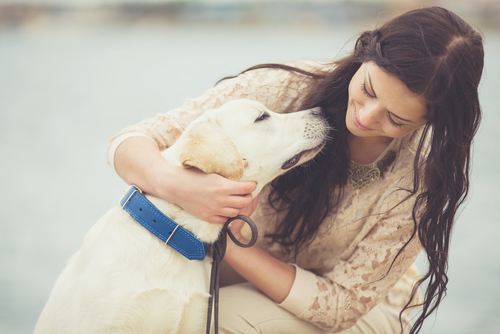
Dogs have a remarkable ability to sense our emotions. Some say they know us better than we know ourselves, and science backs up that theory.
The slightest increase in blood pressure alerts our canine companions that our stress level is rising, while a quick glance at our facial expression lets them know whether we are happy or angry. Our dogs can even influence our emotions just by gazing into our eyes.
How do they tune into our innermost feelings? And how does this skill affect the unique bond we share with our canine companions?

Why Do Dogs Care About Human Emotions?
Our symbiotic relationship with dogs began 15,000 years ago when we offered them warmth, shelter, and food in exchange for protection and companionship.
That bond continues to grow and strengthen to this day. For example, canine pack members do not routinely look into each other’s eyes during bonding. In fact, this behavior is typically seen as a challenge or threat among dogs.
However, humans do engage in prolonged eye contact, especially with those we love. Domestic dogs have not only learned to look us in the eye, but they’ve even “hijacked” the famous oxytocin gaze-positive loop most commonly observed between new mothers and their babies.
As our species continue to evolve side-by-side, our smart, resourceful dogs persistently adapt to our way of life. They are so good at sensing our innermost feelings, it sometimes seems like they can read our minds!

Dogs Sense Our Emotions By:
1. Reading Our Body Language
Author and professor emeritus, Albert Mehrabian discovered that 93% of human communication is non-verbal. Both humans and dogs communicate through vocalization, but we also tend to trust what we see above what we hear.
When greeting a new pooch at the park, dogs avoid stiff, aggressive-looking pups in favor of happy, relaxed playmates. They do the same when it comes to sensing our emotions. A quick glance at our posture, gait, and mannerisms tells them everything they need to know about our current mood.
Dogs are so good at reading our body language they beat out wolves, chimps and three-year-old children in social cognition experiments. Even nine-week-old puppies that have never lived as pets read us better, suggesting this skill is evolutionary.

2. Studying Our Facial Expressions
Humans and primates have a social trait known as “emotional contagion.” It’s why we yawn when a friend yawns, and why we tend to return the smile of a passing stranger. Matching the emotions and physical expressions of our fellow humans demonstrate our high capacity for empathy.
Dogs also perform a similar kind of social mimicry with each other. Italian researcher Elisabetta Palagi and her team studied dogs interacting at the park and found that not only do they match each other’s body postures, but they also mimic facial expressions, especially with dogs that they’re already familiar with.
The authors believe emotional contagion also exists between dogs and humans. When our eyes meet theirs, they raise their eyebrows to show they’re engaged. When a dog parent yawns, their dog often does the same.
In addition to simply mirroring our looks, there is strong evidence that dogs can recognize and understand the difference between happy and angry facial expressions in humans.

3. Sensing The Emotion In Our Voice
Dogs can detect high frequencies and sounds more than four times farther away than humans can. These powerful organs come in handy when dogs sense our emotions.
Studies show they respond similarly to humans when exposed to sounds of babies in distress. They become visually upset and release the stress hormone cortisol, suggesting they understand that crying is a negative human sound.
A 2014 study found that dogs can also detect variations in tone and mood in the voices of fellow dogs and humans. Just like us, they understand emotional voice cues which is another strong indicator they are capable of empathy.

4. Sniffing Out Chemical Changes In Our Bodies
Our dogs’ noses are 10,000 to 100,000 times more sensitive than our own with 300 million olfactory receptors compared to our measly 6 million. Scientists have likened their sniffing ability to “catching a whiff of one rotten apple amid two million barrels.”
We know that dogs can smell subtle chemical changes within the human body that indicate a variety of medical conditions. But can they actually “sniff” out our emotions?
Researchers at the University of Naples conducted a study to see if dogs could smell the difference between human body odors produced during happiness and fear.
Volunteer “odor donors” were shown a video to induce either fear or happiness, and their sweat was collected on pads. The canine test subjects were then exposed to samples of “happy sweat” and “fearful sweat.”
In the presence of the fearful odors, the dogs’ heart rates went up and they sought comfort from their owners. This led researchers to conclude that not only can dogs smell our emotional state, they also tend to take on those emotions as well.

5. Using The “It” Factor
Until 2019, scientists could not explain how dogs sensed impending seizures in humans. They had no doubt they could do it, they just could not pinpoint exactly what it was the dogs see, hear, smell, or feel to tip them off.
While this mystery has been solved, there are still some incredible ways dogs sense our emotions that we don’t fully understand. Call it a sixth sense or an “It” factor.
The most striking example is our dogs’ uncanny ability to sense “bad” people or those with ill intentions. We all know that dogs tend to be excellent judges of character, but how do they do it?
The truth is, scientists aren’t quite sure. It could be a simple instinct and a determination to trust their intuition. Or maybe dogs pick up on nervous energy radiating from these unsavory characters.
Most likely it has something to do with those incredible noses. When an average person has aggressive intentions, their brain chemistry undergoes changes that dogs may be able to smell before their human ever senses a threat.
If this is the case, even our dogs won’t be able to save us from a psychopath. Since they experience fewer emotions, their brain chemistry is unlikely to alert our dogs to their cruel intentions.

Has your dog ever alerted you to a dangerous person, helped detect a health problem, or identified exactly how you were feeling? Let us know in the comments!
The post 5 Ways Science Says Our Dogs Can Sense Our Emotions appeared first on iHeartDogs.com.
from iHeartDogs.com https://ift.tt/38OIA13


No comments:
Post a Comment